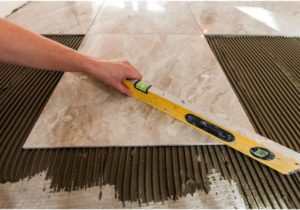Thinking about replacing your outdated ceramic tile floor with new laminate flooring, but unsure where to start?
Good news—you can install laminate flooring over ceramic tile! It’s a smart and cost-effective flooring solution that saves time, avoids demolition, and transforms the look of your home.
In this step-by-step flooring guide, we’ll explain everything you need to know—from checking if your ceramic tile subfloor is level and secure, to choosing the right underlayment for sound insulation and moisture control. We’ll also walk through key tips on floating floor installation, surface preparation, and ensuring a smooth, long-lasting finish.
Can You Install Laminate Flooring Over Ceramic Tile?
Can you install laminate flooring over ceramic tile? Absolutely—it’s a popular home improvement solution for homeowners looking to upgrade their space without removing existing ceramic tile floors. This method works well if the tile surface is clean, flat, and structurally sound. To ensure proper installation, a high-quality laminate underlayment is typically used to create a smooth base and protect against moisture damage.
Laminate flooring is known for its durability, wood-like appearance, and comfort underfoot, making it ideal for living areas and bedrooms. Before getting started, inspect your ceramic tile for cracks or uneven areas. Any tile over 1/4 inch in height or with significant damage should be repaired or leveled first.
Doing proper prep work and selecting the right flooring materials will improve your results and extend the lifespan of your new floor. This approach not only enhances the style of your home but also ensures your floating floor installation remains stable, water-resistant, and safe for everyday use.
Advantages And Disadvantages: Can You Install Laminate Flooring Over Ceramic Tile?
There are advantages and disadvantages to installing laminate flooring over ceramic tiles that are already in place. The biggest advantage of laminate flooring is that it is simpler to clean, particularly after spills. It is important to keep in mind, though, that laminate might not be the ideal option for absorbing sound, which could cause your area to reverberate more quickly.
Selecting laminate flooring gives an effortless and inexpensive installation process than vinyl flooring. It will feel warmer underfoot and you won’t have to remove your existing ceramic tiles like you would with vinyl flooring. However, it’s essential to recognize some potential complications.
For example, to prevent drastically changing your floor height, you’ll need to monitor the laminate’s thickness. Furthermore, an uneven or rough tile surface can promote the deterioration of the laminate; therefore, complete preparation is essential to reduce the possibility of costly repairs due to warping or cracking.
When considering your options for updating your house, especially if you want to save money and time, considering the advantages and disadvantages of installing laminate over existing ceramic tile will help you make an informed choice.
Preparing Tips
It is essential to do a comprehensive assessment before starting the process of installing laminate flooring over the existing ceramic tiles. Make sure there are no chips or cracks in the tiles, and use epoxy to fill in any grout seams to provide a level surface on which to lay the laminate flooring. After cleaning the surface with a soap and water solution, you can use a blower fan to speed up the drying process or leave it to air dry.
To have everything ready, do the following:
- Secure any loose sections thoroughly to ensure stability.
- Fill up any chips or cracks using a resin-based filler.
- Use a leveling compound to smooth out any sinking that may have developed on your tiles.
Building a strong foundation is essential to preventing problems later on, so making sure that these steps are completed correctly is necessary. When you put your new laminate flooring over existing ceramic tiles, an even, well-prepared surface makes a great foundation for the underlayment tile.
Steps For Installing Laminate Flooring Over Ceramic Tile
You are now prepared to install your new laminate flooring over the ceramic tiles that were previously there. By closely following these important steps, you can guarantee the stability and durability of your floor and create an aesthetically pleasing surface.
Step #1: Condition The Ceramic Tiles
Laminate flooring can be installed over ceramic tiles if the tile is in reasonable condition and does not have any loose, chipped, or cracked tiles. It’s not a good idea if they are loose, chipped, or cracked. To fully even out uneven or bulging tiles before installing laminate, you can also apply a leveling compound throughout the entire tile gap.
Step #2: Level The Tile Surface
For your laminate flooring installation to be successful, you must make sure the tile surface is level. A leveling compound is your best bet for leveling off any subfloor abnormalities and filling up any grout lines or dips if you discover that the tiles are uneven.
By placing down a sturdy, level foundation, you reduce the possibility of later pressure point cracks in the laminate, which ensures an outstanding finish for your flooring project.
Step #3: Choose The Right Underlayment
Choosing the right underlayment material is essential for a successful laminate flooring installation over existing ceramic tile. Utilizing foam or cork cushioning provides a level surface for securely placing planks and serves as a moisture barrier to prevent water damage. Always adhere to the manufacturer’s directions when choosing an underlayment to match your particular laminate brand.
This base layer provides more advantages including sound absorption and insulation along with aesthetic appeal. Whether you’re installing laminate over ceramic tile in a residential or business space, it’s an essential part of creating a long-lasting and visually appealing new floor.
Conclusion
Can you install laminate flooring over ceramic tile? YES! But please make sure that there are no cracked, broken, or missing tile pieces before laying your laminate over the ceramic tile. Any flaws in the tile may result in problems during installation, as well as future problems from moisture, contrast, and expansion. In case you plan to use the tile again, you should get a click-lock product instead of a glue-down.
Frequently Asked Questions
Can you put laminate flooring over tile?
Yes, you can put laminate flooring over tile, but it’s essential to ensure the tile surface is in good condition. The tiles should not be cracked, loose, or chipped. Preparing the surface by cleaning, leveling, and filling grout lines or imperfections with a leveling compound is key to creating a smooth base. Additionally, using an appropriate underlayment, such as foam or cork, provides moisture protection, sound absorption, and a sturdy foundation for the laminate. Proper preparation ensures a durable and attractive installation.
What type of flooring can you put over ceramic tile?
You can install laminate, vinyl, engineered wood, or carpet tiles over ceramic tile. Laminate is a popular choice for its cost-effectiveness and ease of installation, provided the tile is clean, level, and free of cracks. Using an underlayment, like foam or cork, ensures a smooth surface, adds cushioning, and protects against moisture. Proper preparation is key to ensuring durability and a long-lasting finish.
Can you put laminate wood flooring over tile?
Yes, you can put laminate wood flooring over tile! It’s a great way to update your floor without removing the existing tile. Just ensure the tile surface is clean, level, and free of cracks or chips. Use an underlayment, like foam or cork, to create a smooth surface and provide moisture protection, ensuring a durable and long-lasting laminate floor. Proper preparation is key to avoiding future issues.






